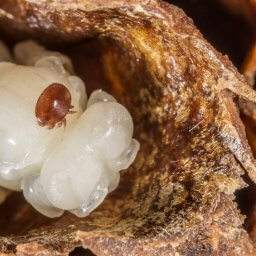
Summer is in full swing, and beekeepers are in the midst of tending to their hives, ensuring the health and well-being of their beloved honeybee colonies. A significant aspect of this care is managing varroa mites, a formidable threat to honeybee populations. There are many popular treatments available, in this article we'll delve into two potent summer treatments for varroa …

As the heart of spring sets bee colonies abuzz with activity, May presents a pivotal time for beekeepers. This month, your hives are expanding rapidly due to the abundant nectar flow, making it crucial to employ effective beekeeping practices. From managing brood nests to optimizing honey production, here are some invaluable tips for both novice and experienced beekeepers to ensure …

In the world of beekeeping, the health and prosperity of your hive can be significantly impacted by tiny invaders. Pests, if left unchecked, can threaten the survival of your colony. At Dadant Beekeeping, we understand the importance of maintaining a healthy and pest-free environment for your bees. Through vigilance and the right tools, you can protect your bees and ensure …

As the grip of winter loosens and the first signs of spring begin to emerge, beekeepers are presented with a critical opportunity to ensure the health and vitality of their hives. This period of transition is a key time for nutrition management, a foundation upon which the success of the beekeeping season is built. Dadant & Sons, with our deep-rooted …

As the first signs of spring begin to show, beekeepers everywhere start preparing for the busy season ahead. Early March is a critical time for hive management, as the colonies awaken from their winter dormancy. Proper preparation during this time is key to ensuring a thriving colony throughout the beekeeping season. In this blog post, we'll share essential tips and …

Secure Your Bees Early: Begin your beekeeping season on the right foot by pre-ordering your bees. Ensuring you have your colonies arranged in advance is crucial for a successful year.
Equip for Excellence: Gear up with the necessary tools and protective wear to manage your hives effectively and safely. From suits to smokers, make sure you're prepared for every …

As the warmer weather of spring approaches, beekeepers everywhere are gearing up to ensure their hives are ready for the new season. At Dadant, we understand the importance of spring hive maintenance in fostering healthy and productive bee colonies. That's why we've compiled essential tips to guide you through inspecting your hives and updating your equipment for optimal beekeeping …

Varroa mites are the bane of any beekeeper's existence. These debilitating parasites stop honeybees from producing honey, which can be crippling for any honey farmer or even those who practice beekeeping as a hobby. Let's find out all about how to prevent varroa mites in your honeybee colonies.
What Are Varroa Mites (Varroa Destructor)?
The official name for varroa mites is varroa …







